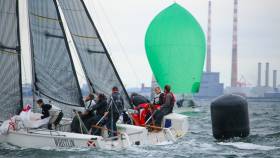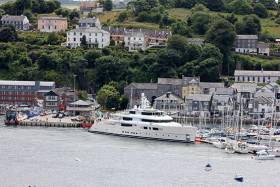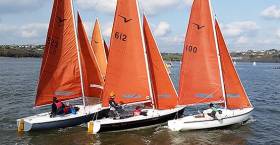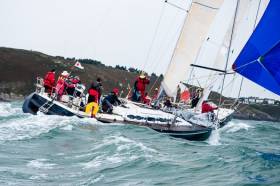Displaying items by tag: Kinsale Yacht Club
Munster Topper Championship Won By Kinsale Yacht Club Sailor
Kinsale Yacht Club hosted the Munster Topper Championships for the first time this weekend. A fleet of 47 boats took to the water on Saturday morning. A strong easterly breeze and heavy seas provided challenging conditions for the sailors and for some this was their first event, but all sailors completed all three races on day one. Download results below.
Michael Carroll, KYC, took line honours in the first race with Micheal O’Suilleabhain, KYC, 2nd and Hannah Liddle, EABC, 3rd. With the fleet pushing hard on the line for the second race a General Recall was inevitable and it restarted under the U Flat. A gear failure early in the 2nd race put Michael Carroll out. Micheal O’Suilleabhain sailed a great race and took 1st Robert Keal, RCYC, 2nd, Dan McGaughey, DSC, 3rd and Sophie Crosbie, RCYC 4th. Race 3 saw Micheal O’Suilleabhain take line honours again , Robert Keal 2nd , Michael Carroll 3rd and Sophie Crosbie 4th.
Sunday the wind was northerly and the seas were a lot kinder to the sailors. Race 4 got under way and from the off it was evident that Micheal O’Suilleabhain and Michael Carroll were battling it out at the head of the fleet. Michael Carroll took line honours with Micheal O’Suilleabhain hot on his heels. Mia Murphy, RCYC, took 3rd with Sophie Crosbie in 4th. Race 5 saw Michael Carroll take the line with Jack O’Sullivan, KYC/RCYC, taking 2nd place, Micheal O’Suilleabhain 3rd and Sophie Crosbie 4th.
Going into the final race it was all to play for as Michael Carroll and Micheal O’Suilleabhain were tied on points. A wind shift saw some sailors take advantage of the left side of the upwind leg which paid off and Tom Higgins, RStGYC, took line honours with Hannah Liddle 2nd and Micheal O’Suilleabhain 3rd. This was enough to secure him the trophy. Michael Carroll was 2nd overall and Sophie Crosbie was 3rd overall.
The 4.2 Fleet saw consistent sailing from it’s competitors with Lewis Thompson, DSC, scoring six 1st Places to take the title, Emma Lynch, WHBTC, came 2nd with Lochlan Briggs, EDYC in 3rd.
Kinsale Prepares for Dragon National Championships
Kinsale Yacht Club welcomes the Cantor Fitzgerald sponsored Irish National Dragon Championships to the south coast port in mid –September.
Joining the local Kinsale Dragon fleet for the event will be boats from the UK, Dublin and Glandore.
Expected to be in contention for the title will be local boat "Little Fella" skippered by Cameron Good along with Dublin boats Jaguar (Martin Byrne)and defending champions Phantom"(Neil Hegarty) both of which finished in the top five of the recent British Nationals (Edinburgh Cup) in Abersoch, Wales.
Kinsale Dragon Class Captain Eoghan O'Neill commented "It's always a privilege to host a Dragon event in KYC and in particular the National Championship as it is the highlight of our racing calendar. September is always a good month for racing in the waters off Kinsale so it should be a great event. We are very grateful to Cantor Fitzgerald who are our title sponsor for the event; they are a global name in stockbroking and investment services"
The event runs from Thursday 15th to Sunday 18th September inclusive and consists of seven races on windward–leeward courses.
1720s Will Fight For National Honours At Kinsale Yacht Club
20 boats are committed for the 1720 National Championships in Kinsale Yacht Club in a fortnight. Class Captain, Clive O'Shea, also expects some other entries that are still in the wings for the three day event that begins on Friday, September 2nd.
It's a busy period for the South Coast Club who will also host the Dragon National Championships ffrom 15th to 18th September.
Half Tonners Hit The Spot for Irish Sailing
With the confirmation that Kinsale Yacht Club will be hosting the Half Ton Classic Worlds from August 14th to 18th 2017, Irish interest will intensify further in a class which already attracts much favourable attention. W M Nixon tells us more about a popular boat type which will have a defending champion from Ireland when the Worlds get under way in Falmouth in Cornwall in a week’s time.
If today’s newcomers to sailing find the resurrection of old offshore racing classes which are apparently only identified by specific weights a bit bewildering, then they can blame the first Commodore of the National Yacht Club in Dun Laoghaire.
The first Commodore of the NYC in 1931 was the Earl of Granard. The club had been founded in 1870 as the Kingstown Royal Harbour Boat Club, and in 1901 it became the Edward Yacht Club in honour of one of Queen Victoria’s many offspring. But with the new mood of the times after Irish Independence in 1922, such a name just wouldn’t do. Nevertheless it was a very sporting gesture when one of the landed aristocracy proposed the new no-nonsense name in 1930, giving it a fair wind by agreeing to be Commodore the following year.
Thus the big change to becoming “The National Yacht Club” was made respectable. But then, the Earl of Granard was a well-respected sailing man in his own right, despite the fact that his ancestral pile in County Longford was about as far from the sea as you can get in Ireland.
Admittedly there was sailing nearby with the North Shannon Yacht Club on Lough Forbes, which incidentally is named after the earl’s family – they were connected to the Forbes of the famous business magazine in America. However, despite the joys of sailing on Lough Forbes, the Earl had long been into bigger things on the international scene, though his interest still had an inland waterways aspect. In 1899 he’d presented a magnificent silver cup to the leading French sailing club, the Cercle de la Voile de Paris (CVP) for an international competition, to be sailed on the River Seine near Paris or on the Solent at Cowes, with the racing between boats which weighed one ton.
Although the trophy’s official name was the Coupe Internationale du Cercle de la Voile de Paris, it soon became known as the One Ton Cup, and continued to be so named even when racing was between yachts of the International 6 Metre Class, despite their weighing several tons apiece.
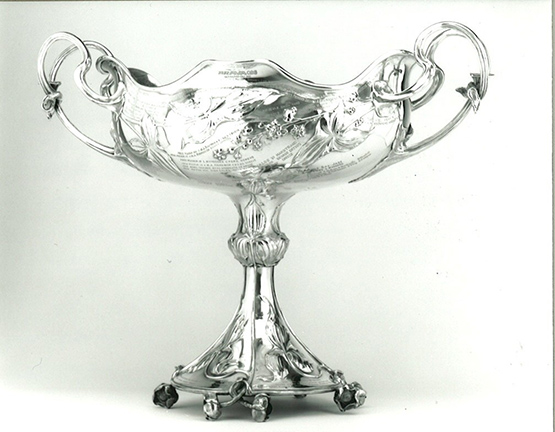 The cause of all the trouble – the One Ton Cup was presented to the CVP by the Earl of Granard, future Commodore of the National YC, in 1898, and was first raced for in 1899.
The cause of all the trouble – the One Ton Cup was presented to the CVP by the Earl of Granard, future Commodore of the National YC, in 1898, and was first raced for in 1899.
The magnificent cup remained as beautiful as ever, but with World War II it became almost forgotten until 1965, when the CVP proposed using it for an inshore-offshore international series for yachts rating at 22ft under the RORC rule, which worked out to be boats around the 36-37ft mark. The idea took off like a rocket - level-rating racing among diverse boats was an idea whose time had come. Very quickly, a whole range of additional international rating levels arose, with Two Tonners around 40-42ft, Three Quarter Tonners around 34ft, Half Tonners around 30ft, Quarter Tonners around 25ft, Mini-Tonners around 21ft, and they even had Micro-Tonners at about 18ft.
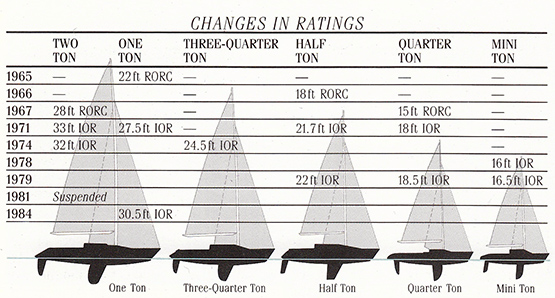 The Ton Classes at their peak
The Ton Classes at their peak
It all worked very well for twenty years and more in some cases (the last Half Tonner was built in 1992), with the boat sizes staying broadly the same size range, but with the ratings changed to accommodate the RORC rule being replaced by the IOR. And Irish sailing certainly had its moments in this continuing circus of various offshore racing acts. In 1974 the Ron Holland-designed, Cork–built 36ft Golden Apple somehow became more famous than the winner by being runner up the One Ton Worlds. But then in 1976, Harold Cudmore and a youthful crew from Cork put all questions aside by managing to get the new race-prepared Ron Holland-designed 30ft Silver Shamrock to Trieste for the Half Ton Worlds, and he won in style, famously celebrating by sailing up the Grand Canal in Venice with spinnaker set.
 The 1976 Half Ton World champion Silver Shamrock, getting an end-of-season lift-out at her current home port of Penzance in Cornwall
The 1976 Half Ton World champion Silver Shamrock, getting an end-of-season lift-out at her current home port of Penzance in Cornwall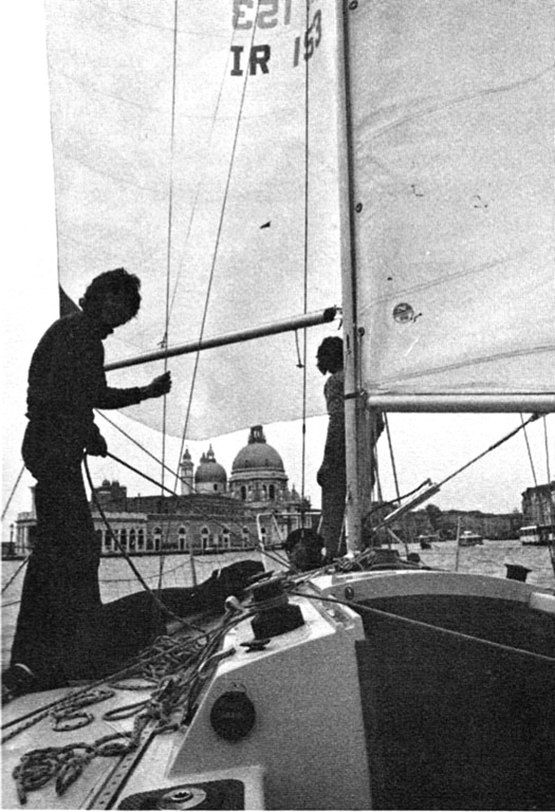 See the conquering heroes come…….Silver Shamrock sailing up the Grand Canal in Venice after winning the Half Ton Worlds 1976 in Trieste under Harold Cudmore’s command. Ronnie Dunphy on left, Killian Bushe on foredeck
See the conquering heroes come…….Silver Shamrock sailing up the Grand Canal in Venice after winning the Half Ton Worlds 1976 in Trieste under Harold Cudmore’s command. Ronnie Dunphy on left, Killian Bushe on foredeck
In 1981 he was back on top again, winning the One Ton Worlds at Crosshaven with the Castro-design Justine IV owned by Frank Woods (NYC). But by this time the boats involved were very different in form from those skinny-sterned designs which had dominated in the earlier 1970s, as a fresh wave of New Zealand designers like Bruce Farr and Laurie Davidson had been showing what could be achieved with broader sterns and better offwind performance.
The Half Ton Worlds was won in 1977, ’78 and ’79 by Kiwi boats of this type. But though she was not the overall winner, Ian Gibbs’ Farr-designed Swuzzlebubble was the one everyone remembered best, as she was on the podium one year as a centreboarder, and back there in the top three the year after, but this time as a keelboat.
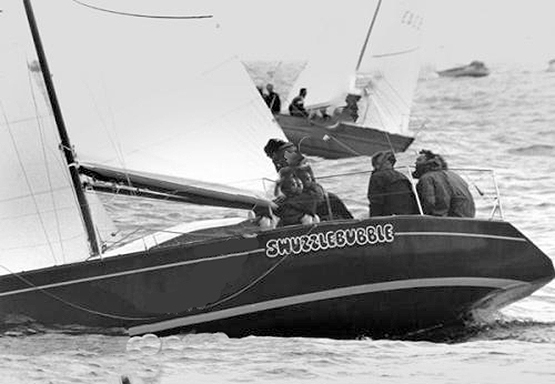 The new wave arrives from New Zealand – Swuzzlebubble in 1979
The new wave arrives from New Zealand – Swuzzlebubble in 1979
The following year she arrived in Ireland in the ownership of Bruce Lyster of Royal St George in Dun Laoghaire, and he won the ISORA Championship in 1980, plus ISORA Week and just about everything for which the boat was eligible in Cowes Week.
He had an exceptional crew of all the talents with Robert Dix, Drewry Pearson and Des Cummins, and Dixie remembers her as one of the most wonderful boats he ever sailed: “She found her own way to peak performance so effortlessly that you’d almost be scared to do anything which might adversely effect the trim” he quips.
He continues to say that even though Bruce Lyster sold Swuzzlebubble to Greece at season’s end, as you simply couldn’t improve on a season like they’d had in 1980. The Three Musketeers meanwhile transferred aboard Ken Rohan’s 40ft Regardless, with which they won their class big time in the 1981 Fastnet.
Regardless would be on most people’s short list for the greatest Irish racing yacht ever, yet Robert Dix remembers the previous season with Swuzzlebubble with even more enthusiasm. So it’s intriguing that at next week’s Henri Lloyd Half Ton Classics Worlds, the new wave of Irish Classic Half Ton sailors will be taking on Swuzzlebubble for the first time.
The story of her re-birth is typical of the modern revival of the very best of the old Ton Cup boats, with the One Ton Championship itself being revived for its Golden Jubilee in New Zealand in 2015 with a classic fleet. As for Swuzzlebubble, she was discovered in a very poor way indeed in a Greek boatyard in 2012, but was brought back to life by the King of Cowes, Peter Morton, who duly won the Half Ton Classics Worlds in Brittany in 2014 with her.
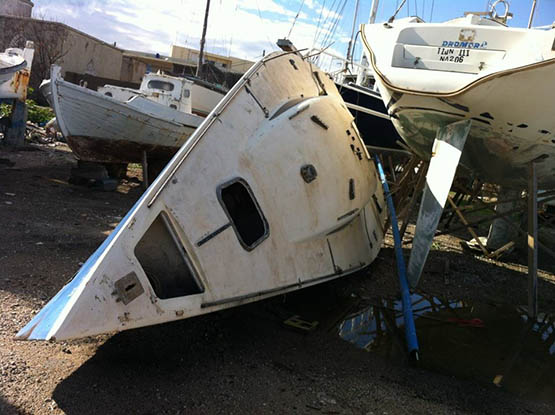 Next stop, the landfill site? Swuzzlebubble as she was found in Greece in 2012
Next stop, the landfill site? Swuzzlebubble as she was found in Greece in 2012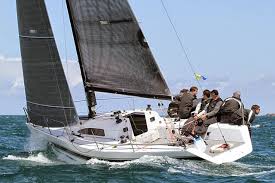 Swuzzlebubble restored, on her way to winning the Half Ton Classics in Brittany in 2014
Swuzzlebubble restored, on her way to winning the Half Ton Classics in Brittany in 2014
However, Swuzzlebubble wasn’t campaigned in the 2015 series in Belgium, when Dave Cullen took the trophy for Ireland with Checkmate XV. So there has been an air of unfinished business about these two rather special boats floating about the ocean without actually locking horns, but that’s all going to be changed in Falmouth.
 Dave Cullen on the helm as Checkmate XV makes a start to die for at the Half Ton Worlds in Belgium, 2015
Dave Cullen on the helm as Checkmate XV makes a start to die for at the Half Ton Worlds in Belgium, 2015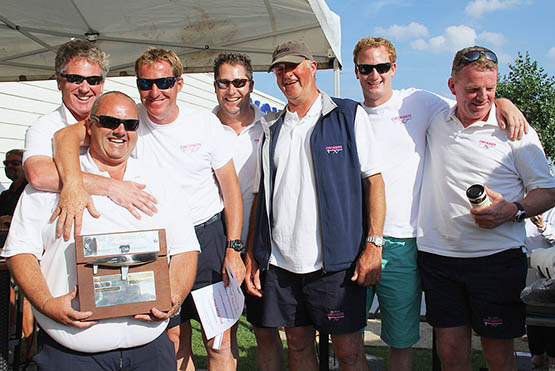 Winners take all – Dave Cullen and his crew with the trophy after victory last year
Winners take all – Dave Cullen and his crew with the trophy after victory last year
In fact, it has become Howth versus Falmouth, as Swuzzlebubble is now Falmouth-owned by Gregory Peck who, in a very varied sailing career, was one of the crew with Dickie Gomes aboard the 83ft catamaran Novanet when a new Round Ireland Record was established in November 1986, but that’s another story altogether.
However, in Falmouth there’ll be other boats involved too, as the word is they might muster as many as 30 entries, which is as big a fleet as anyone could reasonably wish for. The remarkable Howth/Fingal contingent will be there in full strength, as Checkmate XV will be taking the road with Jonny Swann’s Harmony, Michael and Richard Evans’ The Big Picture, and the David Kelly and Patrick Boardman team from Rush SC with King One, Half Ton World Champion in 1981.
It’s an intriguing mixture of nostalgia and modernity, as the boats get revamped to new ideas, yet they always carry their history lightly but definitely with them. In the case of the Howth boats, much of the technical work in revamping is done by ace boatbuilder Alan Power of Malahide, who appropriately is a powerboat nut himself, but his ability to think outside the usual boat-building box makes him the ideal man to undertake crazy notions for addicts of old but still potent offshore racers.
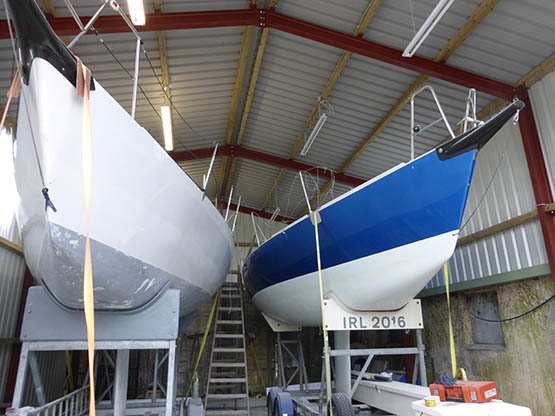
In line with this aim of maximising performance, the Howth/Fingal crewing lineup will include some formidable talent from all over Ireland, with Dave Cullen leading the charge with his 2015 crew of Johnny Murphy, Gary Cullen (no relation), Aidan Beggan, Mark Pettit, James Hynes and Andy George.
The crew on The Big Picture meanwhile have roped in Mark Mansfield of Cork, who is having a great year of it in a variety of boats, while the jockey for King One is young Marty O’Leary, one of the bright new talents to emerge in recent years from Courtown in County Wexford.
Down Falmouth way, it’s going to be Classic Half Ton Racing at its classic best. And if you wonder why it is that the Half Tonners seem to have been the most successful of all the Ton classes in reviving themselves after more than fifty years, perhaps the answer is that at 30ft they’re big enough as boats to be taken seriously, yet small enough to be a manageable proposition for keeping in top order and raced keenly.
 The contemporary Half Ton Classics lineup – the boats are big enough to be taken seriously, yet small enough to be manageable
The contemporary Half Ton Classics lineup – the boats are big enough to be taken seriously, yet small enough to be manageable
Superyacht 'Grace E' Calls to Kinsale
The latest superyacht visitor to Kinsale Yacht Club Marina makes quite an impact alongside at the yacht club pontoon today.
'It's not too often we get these large boats into visit' Matthias Hellstern, Kinsale Yacht Club's Rear Commodore told Afloat.ie
‘Grace E’ is a Superyacht, 73 metres in length and built in 2014 by Perini Navi Group Italy. She won Motor Yacht of the Year at the World Superyacht Awards 2015
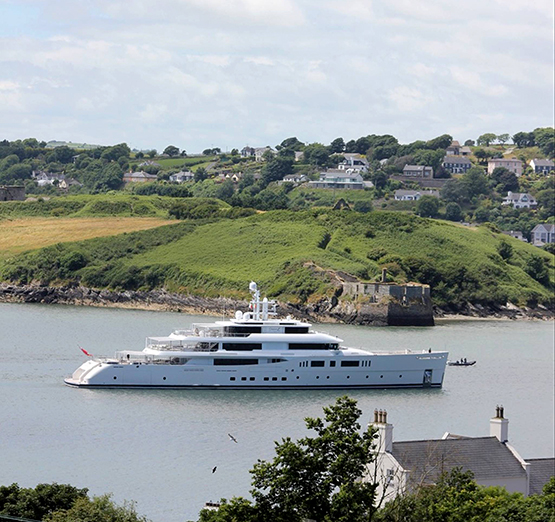 Superyacht 'Grace E' moored in Kinsale harbour
Superyacht 'Grace E' moored in Kinsale harbour
Kinsale Yacht Club Frostbite Titles Up for Grabs
The third week of the Frostbites in Kinsale Yacht Club was run under testing conditions today. When the Committee Boat, got to the racing area there was barely 5 knots of breeze, compounded by the fact that it was out of the NE and there was a very strong tide ebbing, the windward leg was definitely challenging for the competitors.
9 Squibs were on the start line. 1st race saw Viking Gold, Jeff Condell and Jeff Cochrane, trying hard to hold his position at the Committee Boat end of the line but he got pushed OCS and had to go around. Allegro, Colm Dunne and Rob Gill and Fagin, Cliodhna and Finbarr O’Regan, were neck and neck for the first two legs. Colm came down on starboard on a higher line, Cliodhna ran a more direct line to the mark. However Colm jibed onto port and reached in at speed to take the mark and this was to prove a decisive move in the race. Viking Gold put in a great race and despite the recall managed to overhaul the fleet to take 3rd.
The wind picked up to 8 – 10 knots for the next 2 races which made the challenging beat a little easier. Allegro took command from the start by finding clean air on the line. Fagin and Viking Gold were tick tacking for 2nd place. John Stanley and Alastair Christie on Bateleur and Denis and Brid Cudmore on Sensation were not far behind. Fagin rounded the leeward mark ahead and secured 2nd. Viking Gold decided to come up to the finish line on the left side of the course and this paid off by securing him 3rd place ahead of Sensation and Bateleur.
The final race again saw an OCS, this time Fagin got squeezed over the line and had to come around. Allegro and Viking Gold both got clear starts, Allegro rounded the windward mark first and managed to hold the lead for the rest of the race. Bateleur rounded the windward mark in 3rd and had a very strong race. Despite the recall Fagin picked off the fleet one by one and with some serious hiking by Finbarr and great helming by Cliodhna just managed to get ahead of Bateleur on the last tack to the line to take 3rd. Next week Allegro is away so Viking Gold and Fagin have it all to play for.
The Laser Fleet saw only 3 competitors today as 1st & 2nd in the series are away training. Mathias Hellstern took command of each of the races to take 3 bullets, Chris Baker put in a steady performance to come 2nd each race with Nic Bendon taking 3rd. Hopefully next week will see a larger turnout of Lasers.
SCORA Sailors Head For Kinsale Yacht Club Hosted AGM
The South Coast Offshore Racing Association (SCORA ) Annual General Meeting will take place on March 11th, 2016, at Kinsale Yacht Club at 8pm writes Claire Bateman.
The agenda is set out below and it looks like there should be a good evening of discussion and plans for the coming season. Another topic that will come up is the future of club cruiser racing (if any) other than the big events like Spring and Autumn leagues.
The season is looking good all round in all classes with lots of interest being shown from the Juniors through to the Seniors.
Light refreshments will be served and there will be a chance to renew acquaintances and for those receiving prizes to enjoy the anticipation.
AGENDA
1. Apologies
2. Commodore’s Report
3. Income/Expenditure Account
4. Election of Commodore
5. Class Bands:
Class Bands for 2016
Class 0 1.050 and above
Class 1 1.049 to 0.975
Class 2 0.974 to 0.916
Class 3 0.915 to 0.865
Class 4 0.864 and below
This is NO CHANGE from 2015.
6. 2016 Sailing Programme – what do the competitors want?
7. SCORA – last year we asked what future?
8. Following the whitesail discussion last year – what next?
9. Any other business
10. Presentation of Prizes
Top Youth Sailors Head for Kinsale & All Ireland ISA Sailing Championships
Last year's champions Cara McDowell of Malahide Yacht Club and Royal Cork Yacht Club’s Harry Durcan return to defend their ISA All-Ireland Youth Sailing Championships titles in Kinsale this weekend.
The Irish Sailing Association (ISA) received nominations this month from all sailing classes in Ireland for their top sailor to fight it out to become the All Ireland champion. The final entry list is below
Sailing in Topaz dinghies, an eight race series concludes with a medal race on Sunday.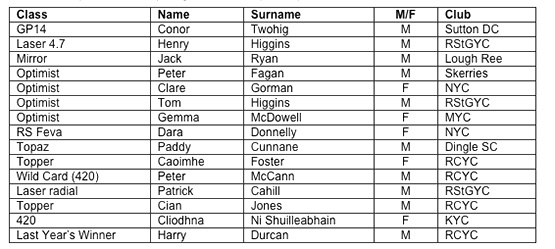
12–Boat Dragon South Coast Championships Begin Tomorrow
Kinsale Yacht Club welcome the Irish Dragon fleet for the 2015 Dragon South Coast Championships which begin tomorrow.
The event runs over three days with two races scheduled per day under the watchful eye of Principle Race Officer Alan Crosbie and his team.
12 entries are expected in what is likely to be an extremely competitive fleet. Title holder Andrew Craig on ‘Chimaera’ will be heading the Dublin fleet with boats expected from Glandore and the local Kinsale fleet headed by ‘Little Fella’ of Cameron Good, Simon Furney and Henry Kingston.
#sovscup – It's only now, with clear signs that the Irish economy is on track to return to vigorous health so long as everyone is reasonably sensible, that we can look for a real upturn in sailing enthusiasm. But with a good fleet getting great racing in the four day ICRA Nats/Sovereigns Cup in Kinsale, there's no denying a growing atmosphere of optimism. WM Nixon muses on the new mood, sets Kinsale in the local and national context, and speculates on the cast of thousands who might be on the podium when the championship finishes this evening.
When Ireland was still reeling from the savage economic downturn which followed the Celtic Tiger years, active numbers in sailing showed a marked decline. The nadir was reached in 2012, when the Irish Cruiser Racer Association failed to raise a three boat team to defend the Commodore's Cup which had been won so stylishly by Anthony O'Leary and his squad in 2010.
That it should have come to this.......After all, at the height of the boom years, there'd been three Irish Commodore's Cup teams competing for the same trophy. So the 2012 No Show served to emphasize the severity of the decline. But ICRA gritted its teeth, and planned accordingly. While Anthony O'Leary quietly beavered away under the radar on what was virtually a solo run in putting together a Commodore's Cup team which was to make a triumphant return to the fray in 2014, the national offshore racing authority had meanwhile been calculating the odds on getting good turnouts in its annual Irish championship.
There were hopes that there would continue to be a respectable turnout when the ICRA Nats were staged in Dublin Bay, as they'd be with the Royal Irish YC in Dublin Bay in 2014. And those hopes were duly fulfilled, even if many boats were racing with older sails than would have been the case in the boom years, while new boats were as rare as hen's teeth.
But for the first of the unforeseeable years beyond 2014, it was reckoned new thinking was required, and ICRA's number cruncher Denis Kiely came up with the notion that for 2015, it would make sense to run the ICRA Nats in conjunction with the established biennial Sovereigns Cup Regatta in Kinsale. To most, it seemed a good idea. A superb venue. And a very experienced race management team with a fine track record in the Sovereigns and other major events. All they needed to demonstrate their capabilities was a decent fleet. But with active cruiser-racer numbers weakened on the south coast, a decent turnout could not be taken for granted without some magic Ingredient X to encourage boats to travel from other areas.
Like it or not, the two words "National Championship" are Ingredient X. And in ICRA's case, there's multiple value, as their National Championship provides racing for a total of nine classes, and seven of those classes are racing under both IRC and ECHO.
It takes a while to get your head round all this, but it means that tonight there could be a total of sixteen different crews who can rightfully claim to be National Champions. Add in further multiple permutations which might just emerge among the minor places, and it's within the remoter realms of possibility that about half of the 109 boats taking part will be able to claim, when they've finally wended their way home along most of the coasts of Ireland and beyond, to have had a podium place in a National Championship.
So what's not to like? For a sailing community emerging from an economic recession so disastrous we still haven't really grasped its extent and depth, an event which aims to provide something for half the people in the audience is just the ticket. And if harsh critics say that this is fantasy sailing, the photos – particularly from yesterday's sun-blessed racing – tell us otherwise.
And as for the venue, well, there's something unreal about Kinsale anyway. It seems too good to be true. Yet it is there, and it's for real. And all the factors which saw it relinquish its position as the south coast's premier Naval Port from around 1750 onwards work together to make it the perfect sailing venue for our own times.

Toytown harbour – Kinsale's compact size made it obsolete as a naval port as ship sizes grew from 1750 onwards, but the same factors make it perfect as a sailing venue today.
For Kinsale is a sort of Toytown. When it was at its height of naval importance, ships were much smaller, and harbour towns had to be as compact as possible to provide them with defence. But as ship sizes grew rapidly, Cork Harbour began to take over, and on Cork Harbour, it was Cobh with its big, new and confident sea-facing terraces of houses which became the expression of a growing naval presence.
By contrast, Kinsale in its great naval period around two or three centuries ago had generally smaller houses which clustered along both sides of a winding and very narrow main street which ran along the shoreline, but didn't provide a waterfront as we know it now. And though the Royal Navy had shifted its emphasis to Cork Harbour, Kinsale continued to house an army garrison to keep the place busy. That's why Kinsale is such a fascinating place to visit by boat. What you see is not what you're going to get. The "new" waterfront may be gradually developing, but the real Kinsale with its myriad of good restaurants and pubs is to be found in a rabbit warren of little streets which hark back to a much earlier age.

Kinsale's rabbit warren of little old streets dates back a long time
 The contemporary waterfront of Kinsale is on reclaimed land along the original uneven and marshy shore. The houses on the south side of the main street had their backs to the sea, and Kinsale YC (on the extreme left) is a mixture of old and new, with the modern south-facing part of the building, looking towards KYC marina, added to the back of a handsome town house which faces north away from the harbour.
The contemporary waterfront of Kinsale is on reclaimed land along the original uneven and marshy shore. The houses on the south side of the main street had their backs to the sea, and Kinsale YC (on the extreme left) is a mixture of old and new, with the modern south-facing part of the building, looking towards KYC marina, added to the back of a handsome town house which faces north away from the harbour.
 Once upon a time, this was the most important trading and naval port on the south coast, but Kinsale today is all about sailing and fishing.
Once upon a time, this was the most important trading and naval port on the south coast, but Kinsale today is all about sailing and fishing.
It has an attractively prosperous and busy air to it all, but it's not so long ago that Kinsale seemed a place in irreversible decay. Time was, though, when it had enough people in business in the 1800s to support busy local sailing, and the Royal Cork YC's most famous trophy, the Kinsale Kettle of 1859, attests to this, while a regatta was reported as early as 1839. The Thuillier family set much of the waterborne pace, and John Thuillier's fascinating book Kinsale Harbour – A History (Collins Press, 2014) puts a complex story into perspective.
Ship and boat building was part of the scene, but sometimes the shipwright branch of the Thuilliers built a yacht, the most famous being the 35ft cutter Tertia from 1898. According to Lloyd's Register, she was designed by a local clergyman, the Reverend Welsted, but the folk in Kinsale reckon the Thuillier brothers put manners on the Reverend's vague drawings to make Tertia a real performer.
Certainly around Kinsale she's remembered as a boat which – during the 1920s and '30s – used to give Harry Donegan's famous Gull a hard time on the competitive course, particularly in the legendary August weekend "ocean race" from Cork Harbour to Kinsale. But inter-harbour rivalry is such that around Cork Harbour – where she was ultimately based, ending her days as a fishing boat in Cobh - she's remembered as the boat in which a very young crew, under the command of the then 15-year-old Clayton Love Jnr, sailed from Cork Harbour to Dublin Bay early in the summer of 1944. Ireland was so cut off from much of the rest of the planet during World War II that it was only when the young sailors arrived into Dun Laoghaire that they found they'd been making their voyage during D-Day, but that's a story for another day.

Tertia, designed and built in Kinsale in 1898. In June 1944, she was cruised from Cork Harbour to Dublin Bay, but her crew of schoolboys only found out after they'd arrived in Dun Laoghaire that D-Day had happened while they were at sea.
By the late 1940s, Kinsale was only a shadow of its former sailing self, but some such as John Henry Thuillier and Dick Hegarty continued to keep the faith, and by the 1950s Kinsale Sailing Cub – nowadays Kinsale Yacht Club – was in being, the pace gradually increasing until it today it is one of Ireland's top ten, and was the Mitsubishi Motors "Club of the Year" in 1998 and 2014.
With its glorious yet compact natural harbour leading into the midst of the hospitable and historic town, Kinsale is Ireland's most popular international cruising destination. But as has been seen these past three days, it lends itself equally well to being a racing venue, and with the weather picking up as the current four day regatta has progressed, we face into the final day with top sport guaranteed.
As for the number of visiting boats, they have been the making of the event. The Royal Irish YC – hosts for the 2014 ICRAs – have sent seventeen spread across most classes, while Howth – who step up to the plate to host the 2016 ICRA Nats – have sent fifteen, with their Kinsale HQ established in The White Lady.

Team spirit. The successful squad from Howth YC have established their Command HQ in Kinsale in The White Lady. Photo: Kevin Burke

The veteran X332 Equinox (Ross McDonald). As the wind has freshened, Equinox has consolidated her lead in Div 2, even though the three Half Tonners had shown ahead in the early races.

The successful modified Half Tonner Harmony (Jonny Swan and Jim Freyne) clearly subscribes to the theory that best speed downwind in light airs is best obtained through keeping weight well away from the stern.
It seems the Howth men and women are in serious training for 2016 already, as they're in there battling at the top of several classes, and even with today's races still to be sailed, your money would be very safe betting on a Howth boat to win Division 2, as they're in the top four places after six races.
The series started in a gentle and muggy southerly breeze, and in the soft going the light breeze specialists did mighty well, with the three hot Howth Half Tonners – Dave Cullen's Checkmate XV, Jonny Swan & Jim Freyne's Harmony, and the Evans brothers' Big Picture – vying for the lead.
But as the breeze sharpened over the next couple of days towards yesterday's sunny power-blast which saw sails torn, spars broken, and four crewmen over the side, Ross McDonald's veteran X332 Equinox found conditions increasingly to her liking, and last night as the discard swung into place, she moved clear on top with a discarded fourth while counting four bullets and a third.
ICRA Commodore Nobby Reilly – also from Howth – has likewise been having a good series up in Class 0 with the Mills 36 Crazy Horse, which he co-owns with Alan Chambers. Crazy Horse's performance hasn't been at all impaired by having the great Dave Harte of Schull on board, though the notching of discards had been to the advantage of Andy Williams from south Devon with the Ker 40 Keronimo (Class 0 find great inspiration in the names of Native American chieftains) which was only two points adrift on the Horse.

The Mills 36 Crazy Horse (Nobby Reilly & Alan Chambers) has the points lead in Division 0 going into the final day's racing in the ICRA Nats this morning.

The Ker 40 Keronimo (Andy Williams, Yealm YC) was a contender for the top slot in Dvision 0, but damage in yesterday's second race has resulted in her withdrawal from today's races. Photo: Courtesy KYC.
However, in the breezy second race yesterday, Keronimo had such a contretemps with her spinnaker that it resulted in serious damage to her pulpit and liferails which cannot be repaired in time for this morning's first race, and she has withdrawn. This means that second overall in Div 0 is now likely to be George Sisk's Farr 42 WOW (RIYC), which is thus doing best in class of the three gallant Dun Laoghaire boats which did the recent Dun Laoghaire to Dingle Race before coming back to Kinsale. The other two are the J/109 Dear Prudence (Bourke, Cummins & Lyons, RIYC) currently 16th in Division 1, which has her astern of the twin-ruddered JPK 9.60 Alchimiste (Mike Murphy, NYC) – Alchimiste is 12th, which is some small compensation for being pipped by Dear Prudence by 50 seconds for fourth place in the race to Dingle.
Division 1 is a seriously strong brew, with Olympian Mark Mansfield of Cork helming John Maybury's J/109 Joker from the Royal Irish in what was developing as a battle with the new British J/109 champion, Ian Nagle's Jelly Baby from Royal Cork. But after yesterday's brisk sport, Scottish Series 2015 overall winner Rob McConnell from Dunmore East has got in between the two of them after scoring a first and fourth with his A35 Fool's Gold.
Division 2 we've looked at already, Division 3 sees another Howth boat on top, but this time it's only equal top for Richard Colwell and Ronan Cobbe's Corby 25 Fusion to lead on count-back, as they're level-pegging on 13 points with Tim Goodbody (RIYC) in the Sigma 33 White Magic. Captain Tim is relishing every minute of sport in Kinsale, as he has indicated that as Chairman of the Volvo Dun Laoghaire Regatta 2015 in ten days' time, he won't have time to campaign his own boat on Dublin Bay. White Magic got a first in the second race on Thursday, and with a second and a fourth yesterday, she's very much in contention.
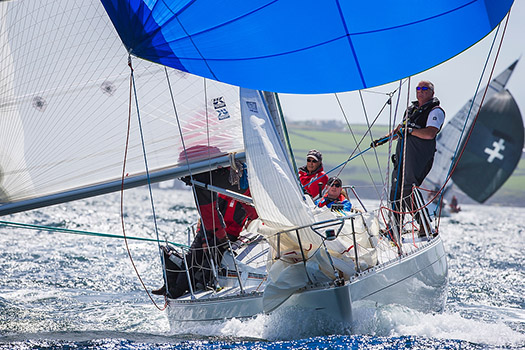
Tim Goodbody blasting downwind in his Sigma 33 White Mischief in yesterday afternoon's race. He currently lies equal first in Division 3 at Kinsale, and it's his last opportunity for some sport afloat before his duties as Chairman of the Volvo Dun Laoghaire Regatta take over completely in ten days time. Photo courtesy KYC
The Quarter Tonners and others in Division 4 are well led by Tony Hayward's Blackfun from Cowes, which – thanks to consistency – is all of ten points ahead of a couple of J/24s, Kilcullen with the Under 25 squad from Howth, and Flor O'Driscoll (who doesn't quite qualify for an Under-25 squad) with Hard on Port from Royal St George YC.
In the two White Sails Divisions which have their starts in civilised style in the harbour off Charles Fort, we just can't sidestep the fact that Howth boats are setting the pace again, with Colm Bermingham's Elan 333 Bite the Bullet three points clear of Paul Tully (DMYC) in his sister-ship White Lotus in Non-Spin Div 1, while Non Spin Div 2 sees HYC's Windsor Laudan and Steph Ennis with the Club Shamrock Demelza (winners in 2014) ahead again in 2015 after logging four wins in the first four races.
Having sailed with this formidable duo in the ICRA Nats 2014, this is no surprise – they're a marvellous testimony to the racing potential of a good old boat well tuned, well cared for, and well sailed. But with plenty of wind expected from the south by this afternoon to round out the ICRA Sovereigns 2015, the Demelza team - together with all the other front runners in all divisions under whatever handicap systems – are going to have to play it cool to bring this great regatta to a safe and successful conclusion before the weather goes down the tubes again tonight.

Heading out from the start in Kinsale for yet another win. Demelza is probably the most successful of the veteran Club Shamrocks designed by Ron Holland in the 1970s. Currently owned by Windsor Laudan and Steph Ennis, Demelza won Div 2 (Non-spinnaker) in the ICRA Nats 2014 in Dublin Bay, and looks likely to complete a successful defence today at Kinsale. Photo: Peadar Murphy
Results – ICRA Nationals & Sovereign's Cup 2015
Day 3, after 6 races sailed (26th June 2015)
Division 0 IRC
1 Crazy Horse, Norbert Reilly/Alan Chambers (Howth Yacht Club)
2 Keronimo, Andy Williams (Yealm Yacht Club)
3 WOW George Sisk
Division 0 ECHO
1 Godot, John Godkin (Kinsale YC)
2 Forty Licks, Jay Colville, East Down YC
3 Roxstar, Jonathan Anderson, (CCC)
Division 1 IRC
1 Joker 2, John Maybury, (Royal Irish Yacht Club
2 Fool's Gold, Robert McConnell (Wicklow Harbour SC)
3 Jelly Baby, Ian Nagle, (Royal Cork Yacht Club)
Division 1 ECHO
1 Adrenalin, Joe McDonald (National Yacht Club)
2 Indecision, Declan Hayes (RIYC)
3 Gringo, Tony Fox (NYC)
Division 2 IRC
1 Equinox, Ross McDonald, (HYC)
2 Harmony, Jonny Swan/JamesFreyne, (HYC)
3 Checkmate XV, Davie Cullen (HYC
Division 2 ECHO
1 Harmony, Jonny Swan/JamesFreyne, (HYC)
2 Dexterity, Foynes Team (Foynes YC)
3 Black Velvet, Leslie Parnell (RIYC)
Division 3 IRC
1 Fusion, Richard Cowell, (HYC)
2 White Mischief, Timothy Goodbody, (RIYC)
3 Bad Company, Desmond, Ivers, Deasy (RCYC)
Division 3 ECHO
1 Powder Monkey, Liam Lynch, (Tralee Bay SC)
2 Maximus, Paddy Kyne (HYC)
3 White Mischief, Timothy Goodbody, (RIYC)
Division 4 IRC
1 Blackfun, Tony Hayward (Cowes)
2 Kilcullen, (HYC)
3 Hard on Port, Flor O'Driscoll (RSt.GYC)
Division 4 ECHO
1 Seven Whistler, Rene Wubben (WHSC)
2 Kilcullen (HYC)
3 No-Gnomes, Leonard Donnery, (RCYC)
J109
1 Joker 2, John Maybury (RIYC)
2 Jelly Baby, Ian Nagle (RCYC)
3 Storm, Pat Kelly (Rush SC/HYC)
Quarter Tonner
1 Blackfun, Tony Hayward (Cowes)
2 Anchor Challenge, Paul Gibbons (RCYC)
3 Quest, Barry Cunnigham (RIYC)
White Sail Division 1 IRC
1 Bite the Bullet, Colm Bermingham, (HYC)
2 White Lotus, Paul Tully, (Dun Laoghaire Motor YC)
3 Baccarat, Brian & Anthony McCarthy (KYC)
White Sail Divison 1 ECHO
1 Baccarat, Anthony/Brian McCarthy (KYC)
2 White Tiger, Tony O'Brien (KYC)
3 Cimarron IV (KYC)
White Sail Division 2 IRC
1 Demelza, Windsor Laudan, (HYC)
2 Loch Greine, Tom O'Mahony (RCYC)
3 Saoirse, Richard Hanley (KYC)
White Sail Division 2 ECHO
1 Privateer, Dermot Lanigan (KYC)
2 Valfreya, David Riome (KYC)
3 Demelza, Windsor Laudan, (HYC)





























